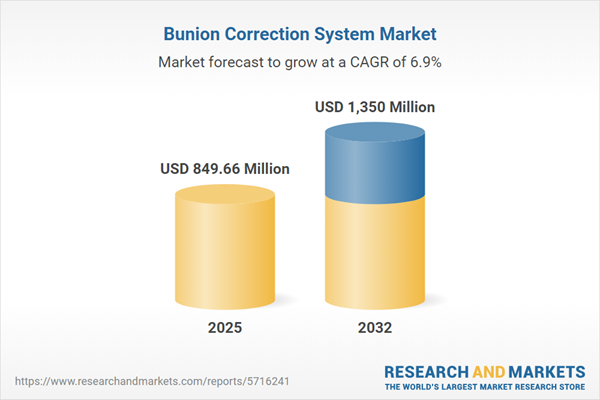Speak directly to the analyst to clarify any post sales queries you may have.
The bunion correction system market is rapidly evolving as healthcare organizations prioritize advanced solutions that increase surgical precision, operational flexibility, and sustainable business strategies. Senior decision-makers in this sector benefit from a focus on targeted interventions and streamlined workflows that align with contemporary clinical and commercial demands.
Market Snapshot: Bunion Correction System Market
Strong growth characterizes the global bunion correction system market, propelled by wider adoption of advanced orthopedic technologies and efficient procedural methods. Specialized implant platforms and continuous progress in surgical techniques are fueling interest in customizable, minimally invasive therapies. Evolving patient demographics and rising expectations for clinical results are intensifying competition and driving organizations to remain agile. Strategic sourcing and adaptive service models have become critical as stakeholders seek to lead in clinical innovation and commercial performance within this dynamic healthcare landscape.
Scope & Segmentation
- Product Types: Stainless steel and titanium plates, intramedullary screws, and surgical staples address requirements for bunion and general orthopedic procedures. Complementary offerings, such as bone drills and forceps, support surgical accuracy. Orthoses like toe separators and external splints are integral to post-operative recovery and ongoing orthopedic management.
- Technologies: The sector includes minimally invasive and open surgical procedures, with notable advances like laser alignment therapies and next-generation precision platforms. These technological improvements enable tailored approaches that address diverse patient anatomical needs.
- End Users: Ambulatory surgery centers, hospitals, clinics, and orthopedic specialty practices form the core market. These settings face protocol updates and increased patient throughput, highlighting the importance of procurement models responsive to operational shifts.
- Distribution Channels: Direct field sales networks, distributor relationships, and rising digital procurement methods compose the market’s supply infrastructure. Each route is calibrated to meet shifting regulatory environments and regional product access requirements.
- Regional Coverage: The Americas facilitate value-driven care delivery and continuously refine surgical standards. EMEA leverages established healthcare frameworks, promoting swift technology adoption. Asia-Pacific growth is energized by investments in healthcare infrastructure and changing patient profiles, facilitating greater integration of systemic solutions.
- Company Profiles: Leading companies—including Johnson & Johnson, Stryker Corporation, Zimmer Biomet Holdings, Smith & Nephew, Arthrex, Wright Medical Group, Integra LifeSciences, Exactech, Acumed, and OsteoMed—adapt to regulatory changes and evolving market conditions, reinforcing their competitive presence internationally.
Key Takeaways for Senior Leaders
- Minimally invasive and laser-guided surgical platforms facilitate greater procedural efficiency, allowing healthcare organizations to achieve improved patient rehabilitation and better clinical outcomes.
- Digital surgery planning tools and bespoke implant technologies, including 3D-printed solutions, elevate intraoperative accuracy and align interventions with unique patient requirements.
- Partnerships among device manufacturers, clinical stakeholders, and technology developers speed innovation cycles and foster the swift adoption of advanced correction systems within healthcare networks.
- Engagement with payers and a clear market positioning strategy are central to navigating evolving regulatory parameters and easing business transitions.
- Reinforcing supplier relationships and localizing sourcing practices help secure supply chains, supporting cost-efficiency and resilience in the face of market disruptions.
- Diversified approaches to market entry and partnerships strengthen regulatory compliance and drive growth across varied regional ecosystems.
Tariff Impact on Bunion Correction Systems
Recent changes in U.S. tariffs on orthopedic device components have increased the incentive for domestic manufacturing and localized inventory management within the bunion correction system market. Companies respond by restructuring supply networks and enhancing collaboration with regional distributors, ensuring greater procurement flexibility. Modular, reusable product designs and regional partnerships are increasingly valued, supporting both sustainability goals and heightened readiness for regulatory or industry shifts.
Research Methodology & Data Sources
This assessment draws on comprehensive secondary research alongside direct input from orthopedic surgeons, device specialists, and procurement professionals. Expert panel reviews and targeted surveys validate insights, ensuring that findings accurately reflect operational and clinical realities within the bunion correction system sector.
Why This Report Matters
- Delivers strategic insights on surgical innovation and emerging business models in the bunion correction system market, enabling informed executive decisions.
- Equips clinical and procurement leaders with practical guidance to streamline operational planning and implement the latest advancements in surgical practice.
- Offers clear recommendations for improving regulatory compliance and operational efficiency across market segments and geographies.
Conclusion
This report provides senior leaders with precise, evidence-based guidance to anticipate market developments, tackle operational challenges, and confidently respond to ongoing technological and commercial changes impacting the bunion correction system market.
Additional Product Information:
- Purchase of this report includes 1 year online access with quarterly updates.
- This report can be updated on request. Please contact our Customer Experience team using the Ask a Question widget on our website.
Table of Contents
3. Executive Summary
4. Market Overview
7. Cumulative Impact of Artificial Intelligence 2025
Companies Mentioned
The companies profiled in this Bunion Correction System market report include:- Johnson & Johnson
- Stryker Corporation
- Zimmer Biomet Holdings, Inc.
- Smith & Nephew plc
- Arthrex, Inc.
- Wright Medical Group N.V.
- Integra LifeSciences Holdings Corporation
- Exactech, Inc.
- Acumed LLC
- OsteoMed L.P.
Table Information
| Report Attribute | Details |
|---|---|
| No. of Pages | 189 |
| Published | October 2025 |
| Forecast Period | 2025 - 2032 |
| Estimated Market Value ( USD | $ 849.66 Million |
| Forecasted Market Value ( USD | $ 1350 Million |
| Compound Annual Growth Rate | 6.9% |
| Regions Covered | Global |
| No. of Companies Mentioned | 11 |









